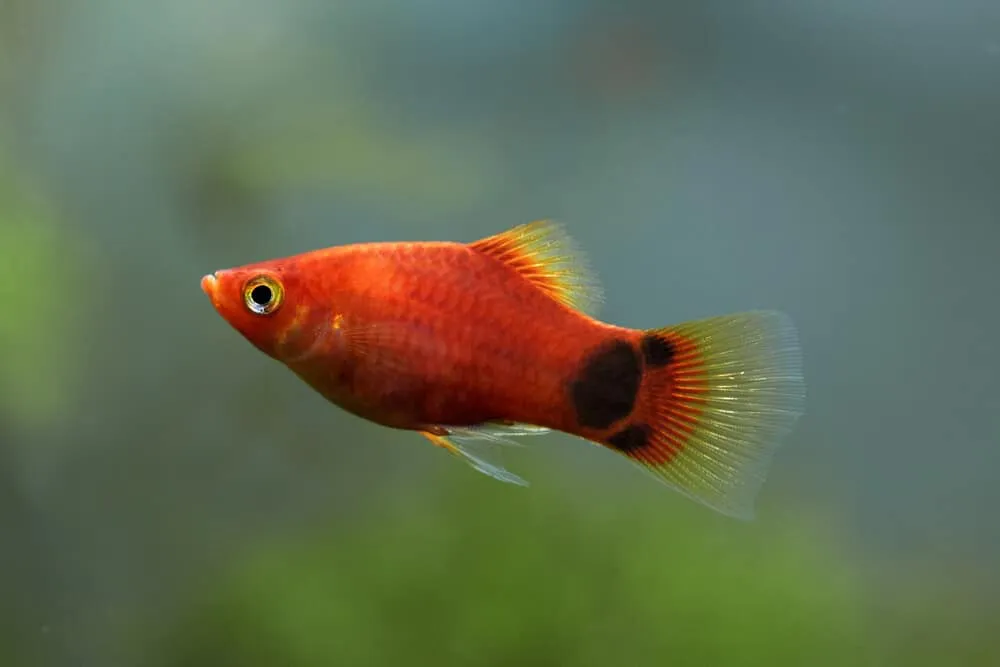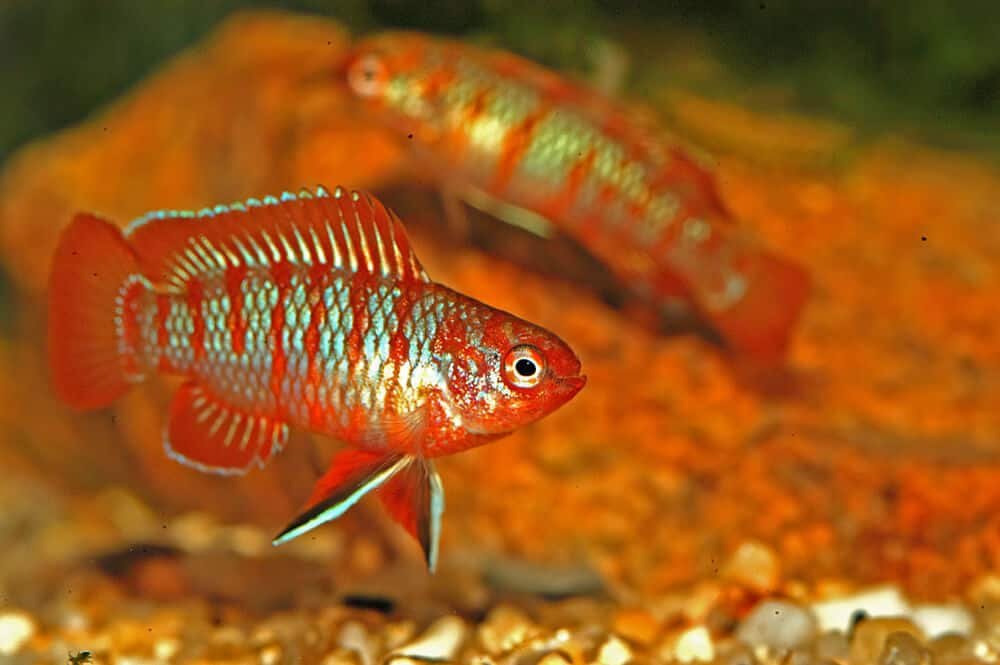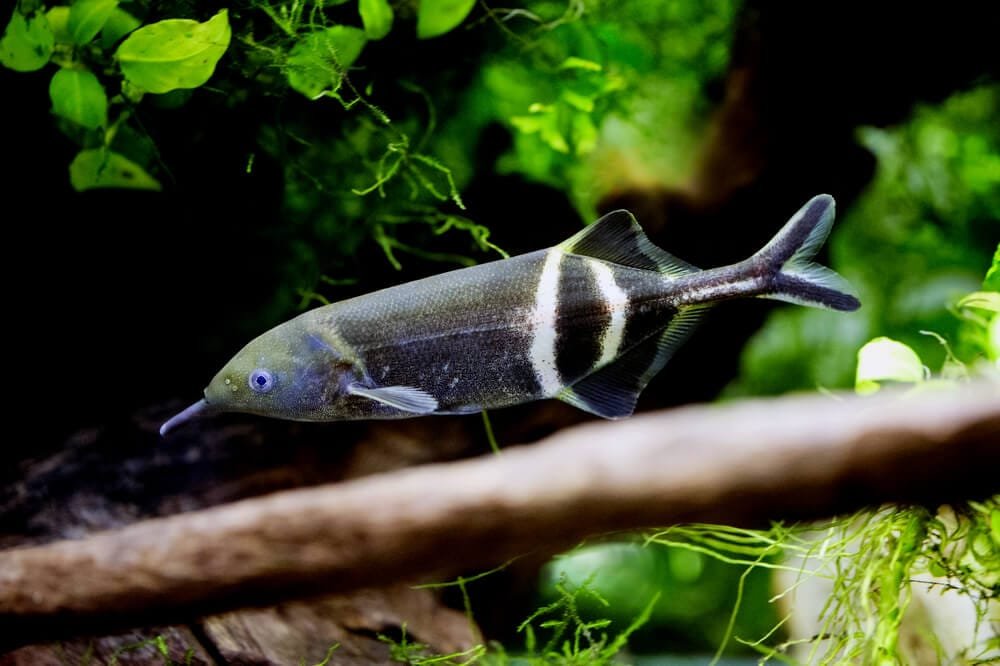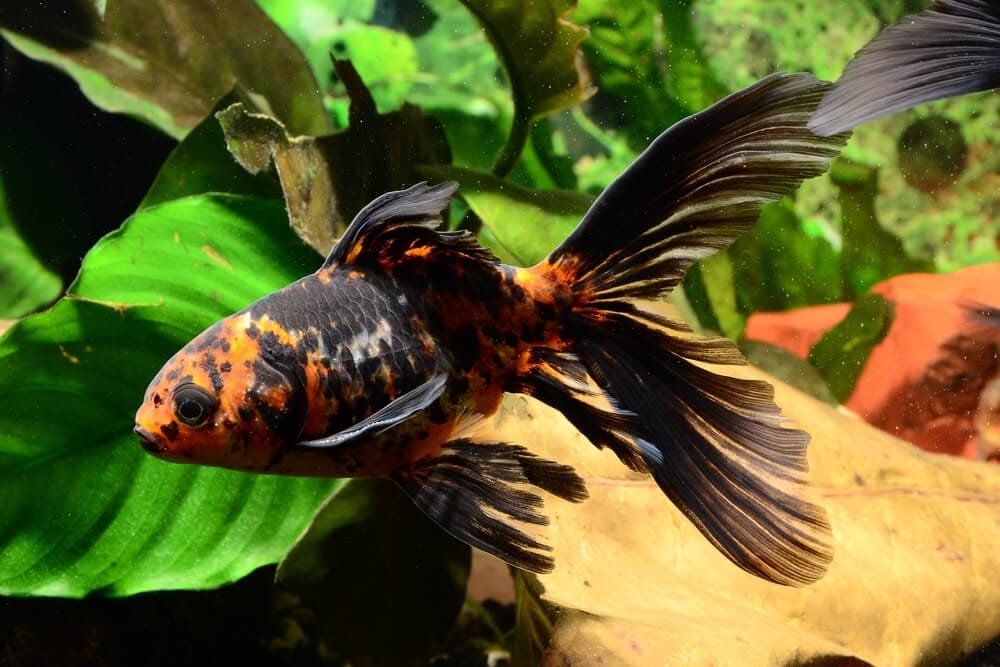The Ultimate Guide To Mickey Mouse Platy

If you are looking for a tropical, freshwater fish that requires very little maintenance and breeds quickly, look no further than the Mickey Mouse Platy. Also known as Moonfish, or Golden Moon Platy, this fish species is a common choice for aquarium hobbyists.
Scientifically, it is known as Xiphophorus maculatus and it belongs to the Poeciliidae family. This fish can live up to 5 years when placed in a tank under the right conditions. If you want to know more about this fish species, this comprehensive guide will prove helpful.
Overview
Scientific Name: Xiphophorus Maculatus
Common Names: Golden Moon Platy, Moonfish, Mickey Mouse Platy
Family: Poeciliidae
Origin: Mexico, Guatemala, Honduras, Nicaragua, and Northern Belize
Social: Peaceful
Minimum Tank Size: 10 Gallons
Size: 1-2 inches (3.5 -5 cm)
Tank Level: Mid-dweller
Diet: Omnivorous
Care: Easy
Breeding: Livebearer
Recommended pH: 7 – 8.2
Ideal Temperature: 64 – 77 °F (18 – 25 °C)
Water Hardness: 10 – 25 dGH
Lifespan: 5 Years
Origin And Distribution
Originally, the fish is from regions in Central and North America such as Mexico, Guatemala, Honduras, Nicaragua, and Northern Belize. Non-native populations of these species can be found in different parts of the USA like California, Florida, and Colorado.
Others inhabit Nevada, Texas, Montana, Louisiana, and Hawaii. Nevertheless, this fish is not labeled as an endangered species despite its wide distribution.
Appearance
The fish gets its name from the round markings near the tail. This fish has three black dots, one large dot, and two small dots that appear like ears, which very much resemble the famed Disney character called Mickey Mouse.
When it comes to color, this fish is available in gold, red, pale yellow, orange, and in some instances blue. The fins of this fish can have a pale yellow, red, or black-tinged color. Like other platies, this fish has a short, stout, and sleek profile.
They are also identified by their triangle-shaped heads and fan-shaped tails. Typically, female Mickey Mouse platies measure about 6 cm long and are relatively larger than their male counterparts, which measure about 4 cm long.
Gender Differences
Although males and females appear similar at first glance, they have their differences. Generally, the fish is sexually dimorphic, meaning that both genders have different appearances.
As aforementioned, the males are smaller compared to their female counterparts. It is easy to identify the male fish because it features a more modified cloacal fin beneath the belly.
This fin is known as gonopodium and is useful for mating for depositing sperm into the female platy. The tail fin is also more pointed in male platys than in female platys.
The females, on the other hand, have a fan-shaped cloacal fan. Mature female platies also have a rounder belly for carrying unborn fry. However, females don’t feature a vibrant color like males.
Typical Behavior
The Mickey Mouse platy is a sociable and peaceful fish that rarely gets aggressive. They are also quite playful and get along with others when placed in a community tank. They love to swim in the mid-area of the tank.
Mickey Mouse Platy Care
When it comes to caring for this fish, there is not a lot that is needed. This freshwater fish is quite easy to care for, making it an ideal choice for beginner aquarium owners.
They are quite hardy and highly adaptable and do well in alkaline water conditions with a pH of between 7.0-8.2. If your tap water is soft, you may need to add more minerals to make it hard. This fish needs to be kept in water temperatures ranging from 64-77°F.
Plus, you don’t need a large tank to keep them. Because of their small, the fish can flourish in a small tank with a small to a medium-sized substrate.
To ensure consistency in the water condition, it helps to check the water regularly. You can use a test kit for this.
The Ideal Tank Requirements
This fish can thrive well when kept in a 10-gallon thanks to their small size. Nonetheless, you may want to get a larger tank to provide more swimming areas for these active fish species.
It is recommendable to place them in a group of between 5 and 8. Ensure that the females are more than the males.
Generally, the tank should be thickly planted with live aquarium plants to provide shelter and allow exploration. Plants also produce oxygen and consume CO2 and harmful nitrates.
Besides plants, you should layer the tank with a dark-colored substrate. This is a good choice since it closely mimics the riverbed sludge in their natural habitat.
The substrate can include things like flat rocks, pieces of driftwood, twisted roots, and glass pebbles. However, the fish is not fussy about the material used in the layer since they are middle-dwellers.
Lights can also be an excellent addition to your aquarium. Not only will lighting the tank help with the process of photosynthesis for the plants, but it will also help your fish maintain a day and night cycle.
When decorating the tank, ensure that you leave plenty of space, especially in the middle of the tank. Otherwise, overcrowding will only make it difficult for this active, freshwater fish to play and explore.
Don’t forget to include a sturdy lid cover on your tank. Like other platies, the Mickey Mouse can jump powerfully out of the tank if not well covered.
Diet And Feeding
The fish needs a well-balanced diet to grow and give birth to healthy babies.
In its natural habitat, the fish is omnivorous, meaning that it can consume most foods. While in the wild, it gladly consumes insects, fry, larvae, and algae.
This platy species is not a picky eater and can eat flake, frozen, freeze-dried, or live food like bloodworms, brine shrimp, and insects. You should also include plenty of vegetables like zucchini, spinach, lettuce, or even cooked peas.
A well-balanced diet will ensure that it gets the necessary vitamins and nutrients for healthy growth. Adults should typically be fed one meal while young ones can be fed two to three times a day.
Something else to note is that these fish species are more avid eaters than some of their tank mates. For this reason, it is highly advisable to place the meal in different places in the tank to ensure that they all get something to eat.
The Best Tank Mates For Mickey Mouse Platy
Since the fish is a peaceful fish, it should be kept in a community tank with other peaceful fish. They especially do well when placed together with other fish species from the Xiphophorus family.
Some of the best tank mates for this fish species include:
1. Guppies
Size: 2 inches
Min Tank Size: 10 gallons
Temperament: Peaceful
Diet: Omnivorous
Care Level: Easy
Guppies make for the most striking and popular aquarium fish. Like the platy, this fish is also friendly, hardy, and are livebearers.
Their requirements for tank size, water conditions, and food are also similar. A difference, however, is that Guppies are shoaling and may require at least a 10-gallon tank size.
Live plants are an excellent addition to an aquarium hosting Guppies. Inside the tank, ensure that you feed them with a pelleted diet once or twice daily and frozen diets and veggies once or twice weekly.
They particularly like commercial foods such as quality flakes to remain healthy. The trick is to feed them a variety of foods to prevent them from getting bored with the same food.
As aforementioned, Guppies are livebearers and they can have more than 50 fries at any given time. To keep their population in control, it is highly advisable to keep the females and males in separate tanks or use tank dividers.
This may also be useful if you want to save the fry from being eaten by their parents. Also, always opt for smaller tankmates if you want the fry to survive.
2. Swordtails
Size: 5.5 inches
Min Tank Size: 15 gallons
Temperament: peaceful
Diet: Omnivorous
Care Level: Easy
Like the platy, the Swordtail is a freshwater fish that hails from Central and North America. It is closely related to the platy and the guppy fish species.
They are peaceful, friendly, and easy to care for. Although they are not shoaling, they make great companions for other peaceful fish species.
Swordtail fish loves to stay in groups of about 5 to 6 and requires a tank that measures 20 gallons. While you need to ensure that the aquarium features heavy vegetation, you won’t need to be picky about their substrate material since they are upper feeders.
Naturally, they are found in freshwater sources like rivers, streams, and creeks. When kept in an aquarium, they flourish in water with moderate alkalinity of about 7.2 pH. The water temperature should range between 72- and 79 degrees F.
The swordtail fish is omnivorous, with plant particles and insects making a large part of their diet in the wild. They will do well with a varied diet of protein-rich meals like meat and live foods and quality flake food.
What’s more, nutritious treats like brine shrimp, frozen and freeze-dried commercial foods, and algae wafers should also be included in their diet. Two to three meals a day will suffice, with the juveniles requiring more protein to grow.
3. Mollies
Size: 4-4.5 inches
Min Tank Size: 1o gallons
Temperament: Peaceful and easy going
Diet: Omnivorous
Care Level: Easy
Mollies make excellent companions for the platies owing to their peaceful and friendly nature. Originally from Southern North America and Mexico, mollies thrive in the freshwater environment and have similar water and tank requirements to the Platys.
This makes it easy for them to cohabit in the same tank. Plus, they are peaceful, easy to care for, and can easily adapt to most tank setups, making them a favorite for beginners.
Mollies are known for their triangular-shaped head, flattened body, and fan-shaped tail. Like the platy, the female version of this fish species is usually larger than the male version.
On average, they measure between 4 and 4.5 inches, although this can vary with the species. There are about 39 species of mollies available at the local store.
Mollies are shoaling and should be kept in a group of at least 4. They love to swim and explore and should be kept in a tank size of at least 10 gallons.
When it comes to the tank setup, mollies prefer taller plants and caves to hide in. The preferred water condition, including the pH and the temperature, can vary from one species to another.
Thankfully, they are hardy and have similar needs to the platy. They are also omnivorous and are not very picky when it comes to their diet.
In the wild, they consume plants and algae. When in a fish tank, Mollies will accept plant-based foods like algae, lettuce, zucchini, and spinach; dry commercial flakes; and high-protein snacks like brine shrimp, bloodworms, and daphnia.
4. Catfish
Size: 1-4 inches (Average)
Min Tank Size: 10 gallons
Temperament: peaceful
Diet: Omnivorous
Care Level: Easy
Also known as a chucklehead or a mud cat, a Catfish is an interesting species that are native to different parts of the world. It is known for its flat and broad head with whiskers on the face.
This fish has landed on many people’s tables as it serves as a common delicacy for cultures worldwide. The Catfish is available in over 3500 species, with one of them being the Cory Catfish.
The Cory Catfish is prevalent freshwater fish in the aquarium trade, and this is for several reasons. This fish will not only add appeal to your aquarium but it is also quite easy to maintain.
Native to South America, it has a peaceful and non-aggressive nature and gets along well with other peaceful fish like the platy. It can, however, get under a great amount of stress when placed in a tank with aggressive fish.
Cory loves to school in a group of about 5 or more. They are very colorful and love to do a water dance, which is truly fascinating to watch.
A Cory is a bottom dweller and loves to spend time scavenging for food. For this reason, it is recommendable to keep them in a tank with plenty of live aquarium plants and rocks to hide and explore.
If you decide to choose this fish as a tankmate for your Platy, ensure that the tank has quality water conditions. Otherwise, they can get stressed and quickly catch a disease when exposed to a tank packed with harmful compounds like nitrates.
When it comes to their diet, the Cory Catfish eats worms, larvae, plankton, and insects in the wild. In an aquarium, they enjoy shrimp pellets, fish flakes, algae rounds, worms, and tropical granules.
Bloodworms and Daphnia are also good choices to treat this fish. Being omnivorous, you should feed them a varied diet to keep the healthy.
5. Neon Tetras
Size: 1-1.5 inches
Min Tank Size: 10 gallons
Temperament: Peaceful
Diet: Omnivorous
Care Level: Intermediate
Neon Tetras are easy to identify by their striking transparent bodies that come in beautiful colors like metallic red, green, and blue. Measuring about 1.5 inches on average, these fish are small and rarely grow large.
Although small, they can be a bit feisty and should not be placed with Mickey Mouse Platy fries as they are likely to eat them. Nonetheless, they are peaceful and passive, and should be added to a tank with non-aggressive fish species.
Also, since they are a schooling species, you need to ensure that you house them in a group of 6 or more in a community aquarium. Being in the company of their own species makes them feel safe and secure.
Because of this, these middle-dwellers are best kept in a large, freshwater tank. They thrive well in a fully-mature tank that measures at least 10 gallons.
Neon Tetras are commonly found in areas with dark water and dense vegetation in their natural habitat. It helps to imitate this environment in your tank by adding plenty of floating plants, low-light, and dark substrate.
They are omnivorous and feed on a wide range of plant and animal materials to promote good health. This includes things like live or frozen foods such as brine shrimp, bloodworms, tubifex, and daphnia, several times a week.
For plant-based food, you can opt for algae wafers, cucumbers, grapes, and strawberries three times a week.
6. Zebra Danios
Size: 1.5-2.5 inches
Min Tank Size: 10 gallons
Temperament: Peaceful and playful
Diet: Omnivorous
Care Level: Easy
The Danio is a freshwater fish that originate from India, Bangladesh, and Bhutan and is found in various habitats including streams, flooded ponds, and rivers. Zebra Danios can grow up to 2.5 inches, with both genders having the same size.
These fish are characterized by torpedo-shaped bodies with horizontal stripes. They are available in a wide range of colors including blue, pink, silvery-green, and purple.
Zebra Danios are playful and can get very active during the day than at night. They are shoaling and love to swim together in groups of 5 or more.
Hence, they require a tank size of at least 10 gallons to sustain their high-activity level. Plus, they are middle and upper dwellers and need plenty of swimming space.
Although they can adjust to a wide range of water conditions, it is recommended to keep the pH levels neutral. This fish species loves its tank decorated with natural-looking things just like their natural habitat.
A good choice is live plants, which offer ample shelter and provide oxygen and nutrients. As for the substrate, Zebras Danios do well in a fine, soft substrate like treated sand.
You should feed your Zebras Danios with live and frozen foods like bloodworms and daphnia. Algae wafers, fish flakes, spinach, and cucumber are other great options.
How To Breed The Mickey Mouse Platy
This fish is a livebearing fish that can breed between 40 and 60 fries. Unlike some fish species which lay eggs, it can give birth to live you, also known as fry.
This fish becomes sexually mature at 4 months. Hence, you may need to separate them as soon as possible if you don’t want to end up with a populous tank.
Since it is an ovoviviparous livebearer, the eggs develop and hatch in the female fish before birth. During mating, the females store the sperm packets, allowing them to reproduce for several months in a row without the need for mating.
If you have both a male and a female Platy in your tank, then there is a high likelihood that the female is pregnant or will be very soon. You will know that the female is pregnant if they have a rounder and have what appears to be dots or fry moving.
Once fertilization takes place, they will give birth after 30 days. Nevertheless, the gestation period can be shorter if the water temperature is warmer.
Unfortunately, the parents are likely to predate the juveniles once they are born, making it necessary to come up with strategies to safeguard them. One way to do this is to offer plenty of hiding spots for the fry to seek shelter.
Similarly, you may want to transfer the mother to a densely planted nursery tank where she will give birth. As she gives birth, the young ones will hide in the plants and you can eventually remove the mother.
The other way is to use a breeding trap that will confine the mother and allow the fry to fall through the slits. However, this can be uncomfortable and distressing for the mother.
After several months, the juveniles will gain color. At this point, you can continue to raise them or sell them to friends or a local fish store.
Frequently Asked Questions
Is the Mickey Mouse Platy prone to any diseases?
Like any fish species, the fish is susceptible to common fish diseases. This may include things like bacterial infections, White Spot Disease, Velvet, and skin flukes. However, this fish species may not suffer from severe health conditions thanks to its hardy nature.
How often should I feed my Mickey Mouse Platy?
You should feed this fish twice a day, with sizeable portions that they can consume in a minute or so. Overfeeding your fish can lead to constipation, bloating, and other health issues.
Also, feeding your Platy more than enough can lead to leftover food, which may eventually start to rot and deteriorate the water quality. Fortunately, you can prevent this problem by including clean-up creatures like snails and shrimp.
How much does a Mickey Mouse Platy Cost?
This can cost anywhere between $2 and $4. This is significantly lower when compared to other fish species like Guppies and Mollies.
Final Thoughts
Ultimately, Mickey Mouse Platy is a small, peaceful, and colorful fish that is sold at a reasonable price in pet stores. If you are just getting started in the world of community aquariums, they may be an excellent choice for you.
Just ensure that you understand their requirements to keep them happy and healthy. When picking tank mates, it helps to choose compatible species that will leave peacefully with your fish.
Start small and keep adding to your community aquarium as you deem necessary.





